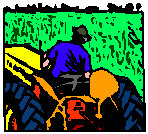

To send a message to an author, click on the author's name at the end of the article.
This Month in Ag Connection | Ag Connection - Other Issues Online

Deciding if a sparse stand needs to be replanted is a difficult decision. Predicting how stand density will be affected by the combination of planting date and changing environmental conditions is the biggest challenge. A step-by-step procedure for estimating the gain or loss from replanting should be followed.
First, the field must be evaluated to determine the extent of the problem and the yield potential. The cause of the sparse stand needs to be determined or subsequent plantings may be similarly affected. Pre-emergence causes could include seed quality, low moisture, crusting, saturated soil, herbicide injury, insect damage or seedling diseases. Post emergence causes could include weather events, diseases or insects.
The next step is to obtain an accurate plant population, which is needed to estimate yield potential. Stand variability will determine the number of areas that need to be sampled. If the population is fairly uniform, fewer samples will be needed. Also, consider if the whole field needs to be sampled since some areas of the field may not need replanting. Count the number of live plants (healthy or capable of recovery) in a given area. Do not count weak plants or plants damaged beyond recovery. Note the condition of the remaining plants in the field, including gaps and their size and the amount of weed pressure.
For corn you can use the following table to calculate stand:
| Row Width | Row Length For 1/1000 Of Acre |
|---|---|
| 30 in | 17 feet, 5 inches |
| 20 in | 26 feet, 2 inches |
| 15 in | 34 feet, 10 inches |
For soybeans, using the hula-hoop method, the following table applies:
| Inside Diameter Of Hoop | |||||
|---|---|---|---|---|---|
| Plants In Hoop | 30" | 32" | 34" | 36" | 38" |
| Thousands Of Plants Per Acre | |||||
| 2 | 18 | 15 | 14 | 12 | 11 |
| 4 | 35 | 31 | 28 | 25 | 22 |
| 6 | 53 | 47 | 41 | 37 | 33 |
| 8 | 71 | 62 | 55 | 49 | 44 |
| 10 | 89 | 78 | 69 | 62 | 55 |
| 12 | 107 | 94 | 83 | 74 | 66 |
| 14 | 124 | 109 | 97 | 86 | 77 |
| 16 | 142 | 125 | 110 | 99 | 89 |
After stand measurement, the next step is to estimate yield potential. Yield is greatly influenced by both environment and genetics. Tables are available in UMC Guide 4091, Corn and Soybean Replant Decisions, that estimate yield potential as a percentage of normal. Do not overestimate or underestimate yield potential, as this will significantly affect the final replant decision.
Then calculate the value of the crop at harvest because predicted market price can greatly influence replant decisions. Even if the yield from replanting would be greater than that from the existing stand, the cost of replanting may be more than the increased yield would return. In determining the total cost of replanting, the grower needs to consider costs such as seed, fuel, machinery, labor, pesticides and additional drying.
The final decision involves taking all of these variables into consideration. With this information, it is possible to determine if replanting is economically justified. In most instances, planting into existing stands is not recommended because plants of uneven sizes and maturity perform poorly. This is particularly true with corn.
More information is available in MU Guide G4091- Corn and Soybean Replant Decisions. It can be accessed at the following location: http://extension.missouri.edu/publications/DisplayPub.aspx?P=G4091
(Author: Wayne Crook, Agronomy Specialist)
This Month in Ag Connection | Ag Connection - Other Issues Online

Most people are able to sell their principal residence without incurring any income tax liability. A tax provision was passed in 1997 and final regulations were issued in late 2002 providing for gain exclusion of $250,000 ($500,000 on a joint return) from the sale of a principal residence.
The basic test for qualifying for this exclusion of gain is that you must have owned and used the home as your principal residence for a minimum period of two years in the five-year period ending on the date you sell the residence.
The final regulations have clarified some important questions regarding this provision. For example, what kind of property can qualify as a personal residence? In addition to the traditional house, the regulations state a personal residence may include a houseboat, a house trailer, or as a tenant-stockholder in a cooperative housing corporation.
The regulations provide guidance relative to the factors to be utilized in determining a taxpayer's principal residence. They include:
The final regulations also provide clarification permitting a fractional exclusion amount if the taxpayer fails to meet the ownership and use requirements due to a change in place of employment, health, or unforeseen circumstances.
This exclusion provision is a very beneficial financial management tool for individuals desiring to sell their primary residences. There is no age requirement for the taxpayer and the funds do not have to be reinvested in another residence. For taxpayers willing to give up their large/expensive family home for a smaller/less-expensive home or home ownership altogether, this gain exclusion provision can create an attractive tax-sheltered retirement vehicle.
(Author: Parman R. Green, UO&E Ag Business Mgmt. Specialist)
This Month in Ag Connection | Ag Connection - Other Issues Online
New traits and seed technologies are being developed continuously as new tools to manage crop production. Available in 2003 are Herculex I, YieldGard Rootworm, and Cyst-X. Another technology in development is the Rps8 gene, which will be available in the near future.

Herculex I offers a broad spectrum of in-plant insect protection according to Mycogen. This corn trait expresses the Cry 1F protein which is toxic to black cutworm, fall armyworm, southwestern corn borer and European corn borer resistance. Herculex I also offers intermediate control of corn earworm and tolerance to over-the-top applications of Liberty herbicide. Dow Agrosciences and Pioneer Hi-Bred International jointly developed Herculex I and received EPA and FDA registrations in the fall of 2001, but delayed the sale until after June of 2002, when Japan also approved it for import.
Another new technology from Monsanto, which has received full registration, is YieldGard Rootworm. The technology uses the Bt protein Cry 3Bb to protect against corn rootworm. YieldGard Rootworm will require a 20% refuge, similar to the requirement for Bt corn products. The new hybrids will be offered in 95- to 114-day maturities. A subsequent registration of Monsanto's YieldGard Plus is expected for the stacked combination of Cry 1Ab protein (which controls European corn borer) with the Cry 3Bb to control corn rootworm. Growers can expect to see a limited offering of both the corn rootworm and the stacked trait.
Dow Agro Sciences and Pioneer Hi-Bred collaboratively expect to develop the Bt proteins Cry 34/35Ab1 to offer growers another choice of corn rootworm resistant Bt hybrids. Syngenta has a corn rootworm-resistant Bt trait targeted for 2005. They also have another Bt trait for European corn borer that can be stacked with the company's rootworm or existing corn borer traits.

For soybeans, there are a few new traits on the horizon. Many Bt proteins are being developed for new crop traits. Monsanto is creating a Bt soybean to control pests such as velvetbean caterpillar. Another new trait developed by researchers at The Ohio State University is Cyst-X. This new trait provides resistance to all known races of soybean cyst nematode. Over 110 companies are currently evaluating this technology. A limited amount of seed with these traits should be available for planting in 2003.
Researchers at The Ohio State University have also discovered another resistance gene for Phytophthora root rot from a South Korean variety. The gene's name is Rps8, which refers to its location on the plant genome. So far, Rps8 has proven effective against phytophthora from 50 Ohio locations where other resistance genes are beginning to fail. If the new gene proves effective against a broad population, it could last from 8 to 20 years. At least another year of research is needed to determine the effectiveness of the new gene and additional field trials are expected.
(Author: Wayne Crook, Agronomy Specialist)
This Month in Ag Connection | Ag Connection - Other Issues Online
The corn flea beetle is a pest where the relative numbers can be predicted in contrast to black cutworm and European corn borer predictions.

Adult corn flea beetles overwinter in grassy areas. When winter temperatures are low (average temperature below 30°F per month), poor survival results and few early season flea beetle problems should occur. High flea beetle numbers and damage are most likely to occur following a warm winter (averages above 33°F per month) followed by a cool wet spring, which slows seedling corn growth. Under these conditions, corn flea beetles have a chance to feed on the seedling corn leaves for a relatively long time. Typical flea beetle damage is a silvering and even death of the leaves. The economic threshold for flea beetles attacking seedling corn is 5 or more per plant with significant feeding when the plants are under cool weather stress. Steward's wilt, a bacterial disease of corn, may also be transmitted by flea beetle feeding.
Adding the average daily winter temperatures for December, January and February are used to estimate the likelihood of flea beetle survival. If the combined monthly average is less than 90° F, then it is likely that few flea beetles have survived. Average combined temperatures between 90° F and 100° F suggest flea beetle damage is possible. When these monthly temperatures are above 100° F, flea beetle survival will be good and damage is likely. This year the southern 1/3 of Missouri had combined average winter temperatures of 107° F. Central Missouri's average daily winter temperatures were 90° F. The Northern Missouri combined average monthly temperatures were 87° F.
Flea beetle numbers will likely be high during the time field corn is emerging over the southern 1/3 of Missouri. Some fields in Central Missouri may have flea beetle problems although the number may be marginal. Corn fields in northern Missouri will probably not have corn flea beetle injury.
An additional factor is the temperature during and just after corn emergence. If it is cool enough to slow or stop early growth, the corn will need to be scouted for flea beetle damage immediately.
Click here to view a table of the average temperatures in December 2002 and January and February 2003.
(Author: Jim Jarman, Agronomy Specialist)
This Month in Ag Connection | Ag Connection - Other Issues Online
Publishing Information
Ag Connection is published monthly for Northeast and Central areas of Missouri producers and is supported by the University of Missouri Extension, the Missouri Agricultural Experiment Station, and the MU College of Agriculture, Food and Natural Resources. Managing Editor: Mary Sobba.